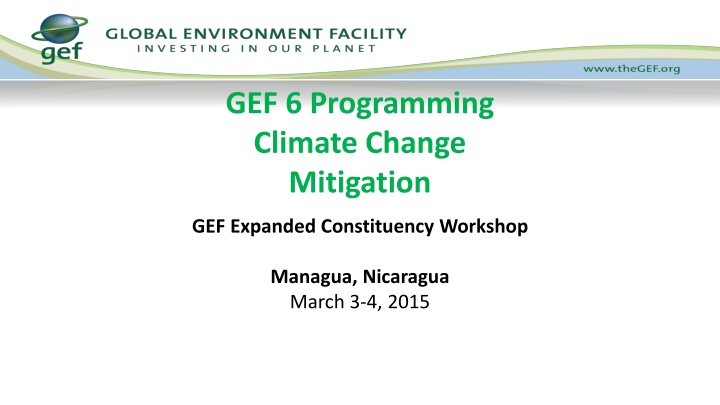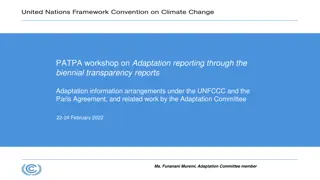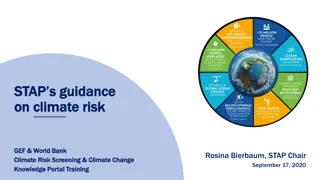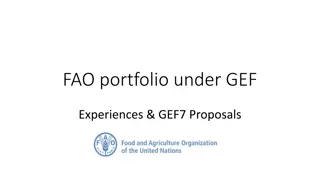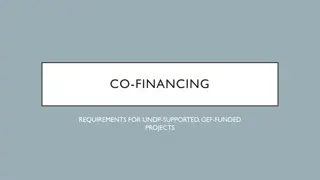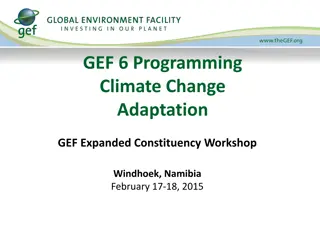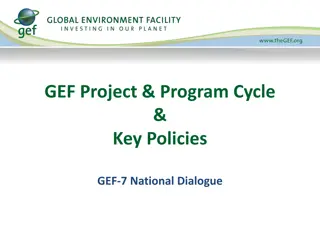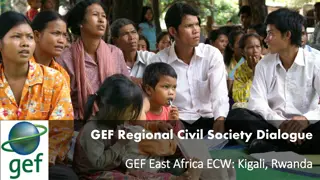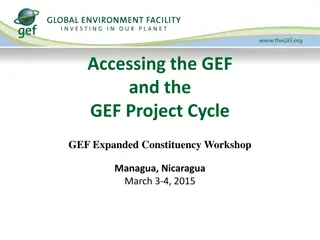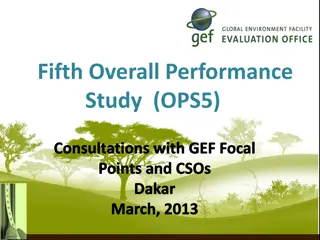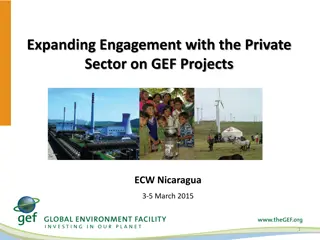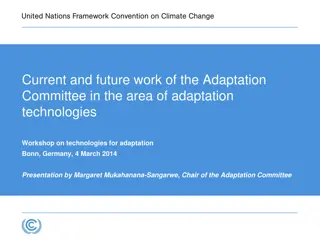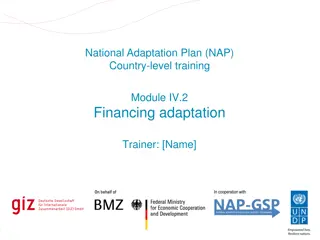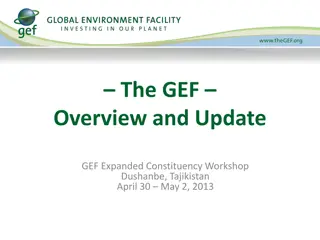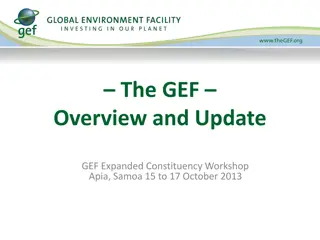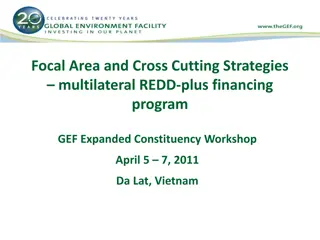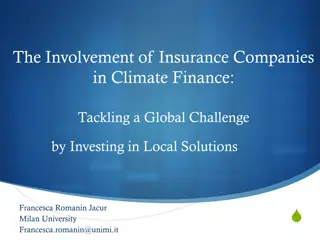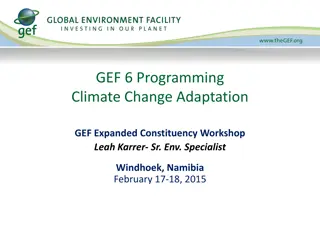GEF-6 Climate Change Mitigation & Adaptation Initiatives
This content provides insight into the Global Environment Facility's (GEF) initiatives for climate change mitigation and adaptation. It outlines the strategies, objectives, and focal areas of GEF-6 programming, emphasizing the importance of innovation, technology transfer, and systemic impacts to support developing countries in transitioning to low-emission, resilient development paths. The document also highlights the efforts towards mainstreaming mitigation concerns and promoting climate-smart agriculture and low-carbon technologies.
Download Presentation

Please find below an Image/Link to download the presentation.
The content on the website is provided AS IS for your information and personal use only. It may not be sold, licensed, or shared on other websites without obtaining consent from the author.If you encounter any issues during the download, it is possible that the publisher has removed the file from their server.
You are allowed to download the files provided on this website for personal or commercial use, subject to the condition that they are used lawfully. All files are the property of their respective owners.
The content on the website is provided AS IS for your information and personal use only. It may not be sold, licensed, or shared on other websites without obtaining consent from the author.
E N D
Presentation Transcript
GEF 6 Programming Climate Change Mitigation GEF Expanded Constituency Workshop Managua, Nicaragua March 3-4, 2015
GEFs Unique Value for Climate Financing 1. Facilitating innovation & technology transfer Assisting developing countries in defining and implementing mitigation measures towards 2015 agreement 2. Catalyzing systemic impacts through synergistic multi-focal initiatives 3. Building on Convention obligations for reporting & assessments towards mainstreaming
GEF-6 CCM Strategy Goal: To support developing countries to make transformational shifts towards low emission, resilient development path Objective 1: Promote innovation, technology transfer, and supportive policies and strategies Objective 3: Foster enabling conditions to mainstream mitigation concerns into SD strategies Objective 2: Demonstrate mitigation options with systemic impacts 5. Convention obligations and enabling activities for national planning and mitigation contributions 1. Low carbon technologies and mitigation options 3. Integrated, low-emission urban systems 2 . Innovative policy packages and market initiatives 4. Carbon stocks in forests and other land-use, and climate-smart agriculture
GEF 6 Programming Climate Change Adaptation
GEF-6: Focal Areas & Funding Sources GEF Trust Fund: STAR Allocation GEF Trust Fund: Set Asides LDCF / SCCF Biodiversity (BD) X Land Degradation (LD) X Climate Change Mitigation (CCM) X International Waters X Chemicals X Integrated Approach Programs (IAPs) X X Sustainable Forest Management (SFM) X X Climate Change Adaptation (CCA) X
Adaptation Programming Strategy: Goal & Objectives 1) Reduce the vulnerability of people, livelihoods, physical assets and natural systems Goal: increase resilience to the adverse impacts of climate change in vulnerable developing countries, through both near- and long-term adaptation measures in affected sectors, areas and communities 2) Strengthen institutional and technical capacities 3) Integrate climate change adaptation into relevant policies, plans and associated processes
Adaptation Programming Strategy: 2 Core Pillars & Innovations Pillars: 1) Integrating CCA into relevant policies, plans, programs and decision-making processes Preparation and implementation of NAPAs 2) Pursing initiatives that cut across both adaptation and other GEF focal areas. Innovations: Private sector engagement & Ecosystem-based Adaptation
Adaptation Programming Strategy: Thematic Priorities Agriculture and food security Water resources management Coastal zone management Infrastructure Disaster risk management Natural resources management Health Climate information services Climate-resilient urban systems Small Island Developing States
GEF-6 Programming Chemical and Waste
GEF-6 C&W Strategy Goal: to prevent exposure of humans and environment to harmful C&W of global importance, including POPs, mercury and ODS, through significant reduction in production, use, consumption and emissions/releases of those C&W Objective 1: Develop the enabling conditions, tools and environment for the sound management of harmful chemicals and wastes Objective 2: Reduce the prevalence of harmful chemicals and waste and support the implementation of clean alternative technologies/substances 3. Reduction and elimination of POPs 1. New tools and economic approaches for managing harmful chemicals and waste in a sound manner 4. Reduction or elimination of emissions and releases of mercury 2. Enabling activities and their integration into sector, national, and global processes 5. Phase out of ODS in CEITs & Article 5 countries under the Montreal Protocol 6. Regional approaches in LDCs and SIDs
C & W Innovative Approaches Piloting of cleaner production to remove toxics including new POPS and mercury from products through partnerships with the private sector. Removing the barriers for investment of the private sector to manage waste streams. Promoting access to finance to small and medium enterprises to allow for investment particularly in waste recycling, ASGM and other sectors that can generate income but are difficult to invest in due to risk or nature of the sector.
Support to IAPs Cities Waste is a key issue for cities, including municipal, medical and electronic waste which contain hazardous chemicals- POPs and mercury PCBs in electrical equipment and the electrical grid POPs pesticides, used in urban agriculture Mercury in products, lighting, etc UPOPs from industrial processes and open burning ODS in refrigeration and air conditioning Amazon Mercury components, specifically Artisanal and Small Scale Gold Mining will be included.
